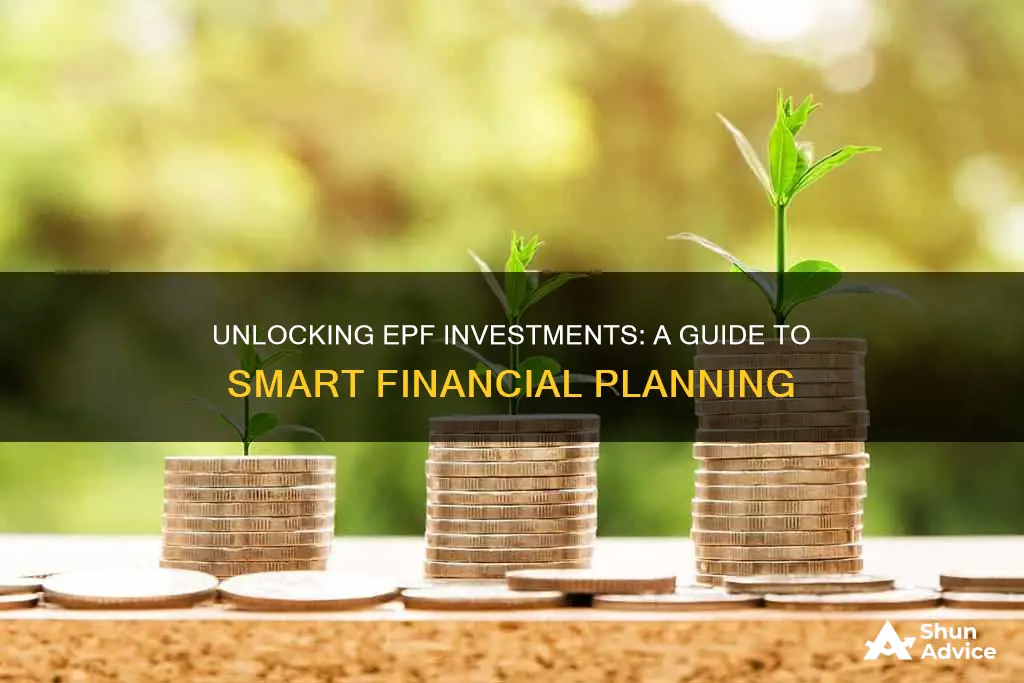
The Employee Provident Fund (EPF) is a significant part of an individual's retirement funds. While it is a good idea to keep this corpus secure, investing it in growth instruments can help keep up with inflation. EPF members can invest their savings in EPF-approved Unit Trusts. However, it is important to note that the interest income on the accumulated provident fund becomes taxable once an individual is out of a job. Therefore, it might be advisable to withdraw the money and invest it elsewhere, such as in a Conservative Hybrid Fund or an Equity Savings Fund.
What You'll Learn

Withdrawing EPF savings to invest in EPF-approved Unit Trust
Malaysia's Employees Provident Fund (EPF or KWSP) allows you to make a partial withdrawal from your retirement savings to meet specific pre-retirement-related needs that comply with EPF's withdrawal policies. One such option is to withdraw your EPF savings to invest in EPF-approved Unit Trusts.
EPF members can withdraw up to 30% of their total amount in excess of their Basic Savings in Account 1. The required minimum investment amount that can be withdrawn is RM1,000. It is important to compute the investment amount that can be withdrawn before investing.
Withdrawal Frequency
You can only withdraw from your EPF savings once every three months to subscribe to one or more unit trusts within the same unit trust company. You must wait for three months from the date of the last withdrawal before investing again.
EPF-Approved Funds
EPF-approved funds are offered by various financial institutions, including Maybank, and are shortlisted by EPF based on their three-year performance.
Risks and Returns
EPF guarantees a minimum dividend of 2.5% per year, and from 2011 to 2020, it made an annualised return of 6.1%. In contrast, unit trust funds offered through the EPF Members Investment Scheme (MIS) have had varying levels of performance, with some funds outperforming and others underperforming compared to EPF. Therefore, it is essential to research the past performance of the unit trust fund before deciding to withdraw your EPF savings.
Fees
When investing through the EPF's MIS, you may incur sales fees of up to 0.5% if investing online via the EPF's i-Akaun portal or up to 3% via the FMI's agent/counter. Additionally, there may be other fees such as annual management fees, transfer fees, and redemption fees. These fees will impact your overall returns and should be considered when deciding whether to withdraw your EPF savings to invest in unit trusts.
Final Thoughts
Withdrawing your EPF savings to invest in EPF-approved unit trusts can be a good way to boost your retirement savings. However, it is important to carefully consider the risks, fees, and potential returns before making any withdrawals.
Millionaires' Secrets: Where They Invest Their Money
You may want to see also

Investing in PPF online
Investing in a Public Provident Fund (PPF) account online is a simple process with banks like ICICI Bank and HDFC Bank. The PPF is a popular long-term investment option that offers a high degree of safety to your investment capital, backed by the Government of India. The scheme has a tenure of 15 years and offers an attractive interest rate of 7.1% that is fully exempted from income tax under Section 80C.
To be eligible to open a PPF account, you must be a resident Indian citizen. Accounts can also be opened in the name of a minor. The minimum deposit amount is ₹500, while the maximum is ₹1,50,000 in one financial year. Deposits can be made in multiples of ₹50 and in the form of cash, cheque, or online fund transfers. You can also set up standing instructions for automatic debit from a linked savings account.
PPF accounts offer benefits such as loans, withdrawals, and the option to extend the investment tenure by a block period of five years after maturity. You can also avail of a loan facility between the third and sixth financial years. After the completion of five financial years from the date of opening the account, you can make partial withdrawals of up to 50% of the balance.
Opening a PPF account online with banks like ICICI is simple and instant if you are an existing customer. You can also transfer your PPF account from another bank or post office to HDFC Bank.
Investment Visas: Global Reach and Country Accessibility
You may want to see also

Opening a PPF account offline
To open a Public Provident Fund (PPF) account offline, follow these steps:
Step 1: Visit the branch of a bank that offers a PPF account. You can choose from a list of authorised banks, including the State Bank of India and its subsidiaries, Central Bank of India, Punjab National Bank, Indian Overseas Bank, and Punjab and Sind Bank.
Step 2: Obtain a PPF Account opening form from the bank branch or the Indian Post portal. You can also download the form from the bank's website, if available.
Step 3: Fill out the form with your personal details, such as your name, age, and address. Make sure to have all the required documents ready, including proof of identity, address, and two recent passport-size photographs. If you are opening the account for a minor, you may also need to provide a birth certificate as age proof.
Step 4: Submit the completed form along with the required documents and make the initial deposit. The minimum deposit amount to open a PPF account is Rs. 500.
Step 5: The bank will verify your application and documents. Once the verification is successful, your PPF account will be opened in your name.
It is important to note that you can only open one PPF account, and the investment tenure is 15 years, with an option to extend for another 5 years upon maturity. The maximum deposit allowed per financial year is Rs. 1.5 lakh, and you must make at least one deposit every year to keep the account active.
Investing Activities: Do Cash Flows Stay Positive?
You may want to see also

Eligibility criteria for investing in the Public Provident Fund
The Public Provident Fund (PPF) is a government-backed savings scheme in India, offering a combination of security, competitive interest rates, and tax benefits. Here are the eligibility criteria for investing in the Public Provident Fund:
Residential Status:
Only Indian residents are eligible to open a PPF account. Non-Resident Indians (NRIs) cannot open new accounts. However, if an individual with an existing account becomes an NRI during the 15-year tenure, they may continue investing until maturity but without the option to extend.
Age:
Individuals aged 18 or above can open a PPF account. Parents or legal guardians can open accounts for minors, but only one account is allowed per minor. Once the minor turns 18, they must take control of the account.
Number of Accounts:
An individual can open only one PPF account in their name. Opening multiple accounts is not permitted, except when a guardian opens an account for a minor. Hindu Undivided Families (HUFs) are not eligible to open PPF accounts.
Account Type:
PPF accounts are intended for individual investors only. Joint accounts are not allowed.
Initial Deposit:
The minimum deposit required to open a PPF account is INR 500.
Annual Contribution:
The maximum annual deposit limit is INR 1.5 lakh.
Documentation:
To open a PPF account, individuals must provide proof of identity (such as an Aadhar card, passport, or Voter ID), proof of address (such as utility bills or an Aadhar card), passport-size photographs, and a nominee declaration form.
Cash Cows: Risky Business and Why You Should Avoid
You may want to see also

Investing in fixed deposits
Assured Returns
One of the biggest advantages of investing in fixed deposits is that you are guaranteed returns on your principal amount. This means that you can be confident that your investment will grow over time, providing you with a stable source of income.
High-Interest Rates
Fixed deposits offer high-interest rates, which can help you grow your EPF savings quickly. For example, Bajaj Finance offers an interest rate of up to 8.65% p.a. on their fixed deposits. This is a great way to maximize your savings and build wealth over time.
Flexible Tenor
When you invest in fixed deposits, you have the option to choose periodic gains. This means that you can decide how often you want to receive interest payments. This flexibility allows you to tailor your investment to your financial goals and needs.
Stability and Low Risk
Fixed deposits are not affected by market forces, so your principal amount remains intact, and there is no risk of losing your investment. This makes fixed deposits a low-risk option for investors, especially those who are risk-averse.
Tax Benefits
Both EPF and tax-saving fixed deposits offer tax benefits under Section 80C of the Income Tax Act in India. This allows you to save on taxes while growing your savings. With EPF, the interest earned and the amount withdrawn at maturity are also tax-free, providing even more tax advantages.
Overall, investing in fixed deposits is a great way to grow your EPF savings and build a stable source of income. With assured returns, high-interest rates, and flexibility, fixed deposits are a popular choice for individuals looking to multiply their EPF money and secure their financial future.
Understanding Capex and Cash Flow: Are They Synonymous?
You may want to see also
Frequently asked questions
You can withdraw up to 30% of the total amount in excess of your Basic Savings in Account 1. The minimum investment amount that can be withdrawn is RM1,000.
You are allowed to withdraw from your EPF savings once every 3 months. You must then wait for 3 months from the date of the last withdrawal for the next investment.
Some EPF-approved Unit Trust funds include Affin Hwang Aiiman Growth, AMB Index-Linked Trust, Eastspring Investments Dana Al-Ilham, and Affin Hwang Select Dividend.







